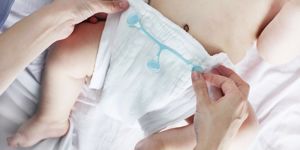Nappies are an essential part of your baby’s life. Whilst the design, fit and comfort of nappies have come a long way since the terry towelling and safety pins of our childhoods, disposable nappies are losing popularity. With a growing focus on environmental concerns such as landfill and the use of plastics, many parents are switching to reusable nappies.
Our guide gives you all you need to know, including the inevitable question of where does the poo go?
What’s a reusable nappy?
OK, so really it does what it says on the tin. It’s a nappy which can be washed, either in the washing machine or by hand, although the vast majority of parents use a washing machine to ensure a hygienic clean. Reusable nappies can be bulkier than disposables, especially if you are using a high absorbency insert or liner.
The cost of reusable nappies can vary greatly. A single reusable can be anywhere between £5 and £40, which compared to buying single-use nappies at around £4-7 for 12 or more nappies.

What types of reusable nappies are available?
The two most common types of reusable nappies are:
Shaped/pocket nappies – an outer waterproof cover (or ‘wrap’) with an insert/liner to absorb the wees and poos. The liners can either be washed or are made of biodegradable materials that can be disposed of. The outer cover comes in a huge variety of colours, styles and once you have one, you'll want loads more, simply because the designs are so cute. The advantage of these being that they have lots of poppers on the outside, making it possible to use on babies from newborn until they're potty trained.
All in one – the cover and the insert are together, which can make for a slimmer nappy
How do I deal with a reusable nappy?
Reusable nappies have very ergonomic designs, so you don’t have to worry about fiddling around with pins or folding the cloth. The nappy will have poppers, plastic clips or Velcro fastenings instead.
Once the nappy has been used, you have a couple of options for dealing with the pooey ones. If it’s solid enough and you can get if off the nappy, flush the poo down the toilet. Or you can chuck it straight into the washing machine, although you might want to use a pre-wash cycle to loosen anything that’s really dried in. You can wait for a load of nappies to be ready to wash, rather than washing one at a time. If you do have separate liners, either dispose of them (if biodegradable) or wash the liner. It’s best to separate the line from the cover before washing, and you can pre-soak if necessary. It is recommended that you wash your nappies at 60 degrees, but check the manufacturer’s guidelines carefully. You can dry your nappies outside or on a radiator, or some can be tumble dried.
Top tips for reusable nappies
You’ll need 10-15 nappies if you are going to be using them on a full-time basis, and less than this if you are using them part-time so that you're not too rushed to wash them quickly.
Washing your reusable nappies make them more absorbent, so aim to wash them at least three times before you start using them. Don’t use fabric softener in the washing machine as this can affect the absorbency.
Check with your childcare provider that they are set up to deal with reusable nappies. You may need to provide them with enough nappies to last a full day, plus some spares if they only offer disposables.
Have a look at the different options available and try out some samples before you buy a large amount. There are different shapes and absorbencies, as well as different liner materials. In some areas of the country, you can access a nappy library or hire scheme.
Reusable nappies are a cheaper long-term option than disposable nappies but do require an additional amount of commitment in terms of washing and drying. Whilst they do reduce the amount of waste going to landfill, you do need to balance this off against the potential increase in energy used for washing (and possibly drying). Before you commit, make sure you do your research!
[Read more: Hacks for Nappy Changing you NEED to Know]



